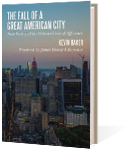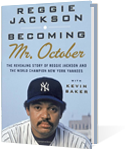By Kevin Baker
The great thing about living in New York used to be that you didn’t have to give a damn about the natural world.
Sadly, those days seem to be gone. Even in my neighborhood, which was lucky enough to be high and relatively dry, things began to resemble a zombie movie by last Wednesday. With nowhere to go and nothing to do, hordes of Upper West Siders staggered about the sidewalks, searching for brunch instead of brains: “Rrrrrr … smoked fish … rrr … hollandaise!”
Now, it seems, we’re all ready to give ourselves a big pat on the back for how we weathered the storm.
Not so fast. Yes, the firemen, cops and emergency workers deserve all the gratitude their weary bones can carry. Yes, plenty of average New Yorkers helped their friends and neighbors.
But as for the institutional response, public or private … Sorry, but 85 dead and counting, over $60 billion in damages, a subway system still not fully operational a week after it shut down, massive blackouts throughout the region, days of gas-line fistfights and raging fires in Queens just doesn’t add up to a good response. (Note to ConEd: when a piece of equipment that’s absolutely vital to keeping the lights on blows up in the first hours of a storm everyone was predicting for days … you’re not doing your job.).
New York has been under assault, human or otherwise, pretty continually for almost 20 years now. And yet the response of our leaders remains basically reactive.
Yes, it’s nice that FEMA is now run by people with detectable brain patterns, and that Gov. Cuomo and Mayor Bloomberg have become staunch believers in climate change. But more needs to be done—much more. And it is probably up to us to do it.
IT’S NOT THAT NO ONE could see this coming. Scientists have been talking about global warming for a generation now. The dean of the city’s investigative reporters, Wayne Barrett, warned five years ago that Bloomberg deputy Dan Doctoroff was deliberately and grossly minimizing the possible effects of hurricanes and rising sea levels in putting together the administration’s much-vaunted blueprint for the future, PlaNYC.
Nonetheless, the Bloomberg administration did all it could to promote massive new developments in nearly every part of the city that ended up underwater last week: the West Side of Manhattan, Williamsburg, Greenpoint, the Queens riverfront, Red Hook, the Rockaways. And plenty more is coming. Remember watching the flood waters sweep over Coney Island? Thanks to an elaborate masquerade the city played with developers, Coney was rezoned two years ago to allow the development of 30 30-story buildings. That’s enough luxury condos to spark a financial crisis as well as an environmental one.
And while global warming is new, New York has been bedeviled by similar weather patterns throughout its history. In the past, we generally managed to learn something from them. The question is if we’ll do so again.
Back near the end of the last Little Ice Age, fierce winds off the Atlantic frequently combined with cold fronts from Canada to batter the city. The “hard winter” of 1779-1780 brought snowdrifts 18 feet deep and a record low temperature of 16 degrees below zero, and froze the harbor solid for five consecutive weeks. New Yorkers adjusted by harvesting the waterways for ice to get them through the summer, and turning them into roadways to get out of town. In the winter of 1821, they even set up makeshift taverns on the Hudson to attract the foot traffic crossing to Jersey.
In March of 1888, a cold front combined with—surprise, surprise—heavy winds off the ocean to suddenly turn a warm spring rain into a howling snowstorm. “The Blizzard of ’88”—or as it was known at the time, “The Great White Hurricane”—became shorthand for natural disaster. In the city, some 40 inches of snow fell, and severe flooding and conflagrations swept New York. The fires alone caused $25 million worth of damage, or more than $600 million in today’s money.
When temperatures dropped to 6 degrees—the coldest ever recorded here in March—the region came to a standstill. New York’s vast webs of telegraph and telephone wires were encased in ice and its many elevated railroads ground to a halt. More than 200 New Yorkers died, some of them freezing to death in the street.
In response, the city began to bury its wires, cables and trains, and professionalized its street-cleaning department. But today, the city’s underground is more vulnerable than ever.
So what to do?
The good news is that many very smart people have already spent a good deal of time thinking about this. Some of their ideas were all over last Sunday’s New York Times, ranging from gigantic, high-tech solutions—vast barriers or gates to seal off much of the city at key chokepoints—to incredibly inventive, low-tech solutions, such as “absorptive streets,” or natural barriers of marshes and oyster beds.
The bad news is that they require leadership and money to be implemented. Neither is likely to come from Washington anytime soon. So we’ll have to do it ourselves. A special tax on, say, stock transactions, or luxury items, or the very highest incomes might raise enough cash—though the usual suspects are likely to balk at a tax for even such an urgent and worthy purpose.
So here’s another idea. Once upon a time, when no government would shell out the money for a pediment on which to place the Statue of Liberty, a newspaper started a campaign to raise the money through thousands of individual donations. In exchange for donations of as little as a penny, Joseph Pulitzer would print their names in the pages of the New York World.
Maybe some newspaper today could start the “Keep Lady Liberty’s Head Above Water Fund,” dedicated to not only preserving our city and region, but also to making it the hub of global climate research and solutions. (Then again, maybe someone else should take this on, given how busy newspapers are trying to keep their own heads above water.)
Our local universities could be persuaded to open new climate change centers, in exchange for the vast amounts of land and legal support we’ve given them lately. Abandoned or underused facilities, such as the Brooklyn Navy Yard or Governor’s Island or the Kingsbridge Armory could be devoted to this purpose. The unemployed could find work building these wondrous new projects. The Bloomberg administration could finally find a reason for its third term.
Of course, simply getting their names in the paperwould hardly suffice for people today. The enterprise I have in mind would operate as an investment fund. As the new technologies, devices and clean energy solutions we produce are put into place around the world—as they surely would be—each investor would get a return on his dollar, once the city’s safety is secured.
New York has been reacting to storms for almost four centuries now. It’s time we got ahead of the next one









